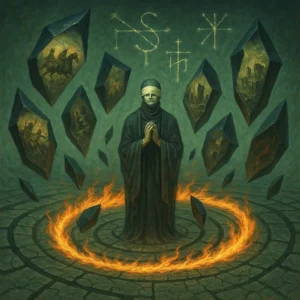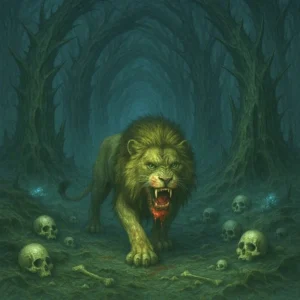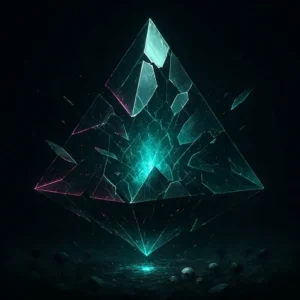Introduction
Album cover art is a visual representation of the music contained within. It serves as a powerful tool for musicians and bands to attract listeners and create a visual identity that resonates with their audience.
Significance of Album Cover Art
Album cover art plays a vital role in attracting listeners and creating a visual identity for musicians and bands. It is often the first thing people see when they come across an album, whether in a physical record store or online. A well-designed cover can pique interest, evoke emotions, and make a lasting impression.
Characteristics of Metal Cover Art
Metal cover art is known for its dark and often elaborate designs that mirror the genre’s aesthetics. It embraces themes such as occultism, mythology, horror, and fantasy. These visuals not only capture the essence of the music but also entice potential listeners.
Some key characteristics of metal cover art include:
- Dark color palettes: Shades of black, gray, red, and purple are commonly used to create a sense of darkness and mystery.
- Intricate illustrations: Detailed artwork featuring fantastical creatures, intricate patterns, or macabre scenes is prevalent in metal cover art.
- Gothic typography: Decorative fonts with sharp edges and ornate details are favored to convey a sense of gothic aesthetics.
- Occult symbols: Symbols associated with occultism, such as pentagrams, sigils, and inverted crosses, are often incorporated into metal cover art.
- Mythological references: Imagery inspired by ancient myths and legends adds an element of mysticism to metal cover art.
Through this article, we will explore the world of metal cover art and learn how to create captivating designs that perfectly complement the genre’s aesthetic. By understanding these characteristics, aspiring artists can tap into their creativity and create mesmerizing metal cover art that captures attention and sets the tone for the music it represents.
The Influence of Metal Music on Visual Aesthetics
Metal music is known for its intense and powerful sound, but it also possesses a distinct visual aesthetic that complements the genre’s themes and emotions. The visual style of metal cover art is heavily influenced by the music itself, creating a cohesive and immersive experience for listeners.
Themes and Emotions: Fueling Visual Style
Metal music often explores dark and complex themes, ranging from personal struggles to societal issues. These themes are not only conveyed through lyrics and sound but also translated into visual form in album cover art.
The raw energy, aggression, and intensity of metal music find expression through striking visuals that capture the essence of the music. From dark imagery to surrealism, metal cover art aims to evoke a visceral response from the viewer and create an emotional connection with the music.
Visual Elements: Occult Symbols and Gothic Typography
Metal album covers frequently incorporate occult symbols and gothic typography to enhance their visual impact.
- Occult symbols such as pentagrams, inverted crosses, and sigils are often used to represent rebellion, spirituality, or otherworldly themes. These symbols add a layer of mystique and intrigue to the artwork, inviting viewers to delve deeper into the music’s narrative.
- Gothic typography is another common visual element found in metal cover art. Bold, ornate lettering with intricate details captures the essence of the genre’s dark aesthetic. It adds a sense of foreboding and grandeur to the overall design, reflecting the intensity and heaviness of the music itself.
Case Studies: Reflecting Subgenre Identities
Different subgenres within metal have their own unique identities that are reflected in their cover artwork. Let’s explore a couple of case studies:
- Black Metal:
- Black metal is known for its raw and atmospheric sound, often characterized by shrieking vocals and fast-paced guitar riffs.
- The cover art for black metal albums tends to feature dark and desolate landscapes, evoking a sense of solitude and mysticism.
- The Norwegian band Mayhem’s album “De Mysteriis Dom Sathanas” is a prime example of black metal cover art, featuring an eerie photograph of a forest with minimalistic typography.
- Death Metal:
- Death metal is characterized by its brutal and aggressive sound, often incorporating guttural vocals and complex guitar solos.
- The cover art for death metal albums often showcases grotesque and macabre imagery, reflecting the genre’s fascination with death and gore.
- Cannibal Corpse’s album “Tomb of the Mutilated” exemplifies this style, depicting a graphic depiction of dismembered bodies with bold typography.
These case studies demonstrate how metal cover art not only complements the music but also serves as a visual representation of the subgenre’s identity.
Drawing Inspiration from the Masters: Iconic Metal Cover Artworks
When it comes to iconic metal cover art, several legendary bands have set the standard with their visually striking and thought-provoking designs. Let’s dive into the world of these masterpieces and explore the artistic merit and impact they have had on the genre.
Pink Floyd’s “The Dark Side of the Moon”
One of the most recognizable album covers in music history, Pink Floyd’s “The Dark Side of the Moon” is a true masterpiece. Designed by Storm Thorgerson and Hipgnosis, the cover features a simple yet captivating prism refracting light into a spectrum of colors against a black background. This iconic image perfectly captures the album’s themes of introspection, time, and human existence.
Black Sabbath’s “Paranoid”
Black Sabbath’s “Paranoid” album cover is a prime example of how simplicity can leave a lasting impression. Created by Keith MacMillan (also known as Marcus Keef), this artwork features a mysterious figure engulfed in smoke against a dark background. The haunting image perfectly complements Black Sabbath’s signature blend of heavy riffs and dark lyrics, creating an atmosphere of impending doom.
Led Zeppelin’s “Untitled” (Led Zeppelin IV)
Led Zeppelin’s fourth studio album, commonly known as “Led Zeppelin IV,” boasts one of the most enigmatic and iconic covers in rock history. Created by Barrington Colby Momford (better known as Zacron), this design features a cryptic combination of symbols that represent each band member. With its mystical allure and intricate details, this artwork perfectly captures the essence of Led Zeppelin’s diverse musical influences.
Iron Maiden’s “The Number of the Beast”
Iron Maiden has consistently delivered unforgettable album covers throughout their career, but “The Number of the Beast” stands out as an enduring classic. Created by Derek Riggs, the cover depicts the band’s menacing mascot, Eddie, emerging from a hellish landscape. This artwork perfectly complements the album’s themes of darkness, occultism, and rebellion, solidifying Iron Maiden’s visual identity within the metal community.
Evolution of Metal Cover Art Styles
Over the decades, metal cover art has evolved from its roots in traditional illustration to incorporate modern digital techniques. The early days of metal saw artists using hand-drawn illustrations to capture the genre’s dark and fantastical themes. As technology advanced, digital art and photo manipulation became more prevalent, allowing for greater experimentation with visuals.
Key Lessons from Iconic Artworks
By studying these iconic artworks, we can learn valuable lessons to apply to our own designs:
- Simplicity can be powerful: Sometimes, a minimalist approach can create a lasting impact that resonates with listeners.
- Symbolism is key: Using symbols and imagery that reflect the music’s themes and emotions can enhance the overall aesthetic and connection with the audience.
- Attention to detail: Paying attention to even the smallest details can elevate your design and make it more visually compelling.
- Experimentation is encouraged: Don’t be afraid to push boundaries and explore new techniques or styles to create unique and captivating artwork.
Drawing inspiration from these masters of metal cover art will help you develop your own style while staying true to the genre’s aesthetic.
Creating Your Own Metal Cover Art: A Step-by-Step Guide
Creating a metal-inspired album cover is an exciting process that allows you to unleash your creativity and design a visual representation of the music. In this guide, we will walk through the process of creating a captivating metal cover art, from setting the mood with typography to applying textures and effects.
Step 1: Setting the Mood with Typography
Typography plays a crucial role in setting the tone and mood of your album cover. When it comes to metal, there are various typographic treatments that can complement the genre’s aesthetic and concept. Here are some tips to consider:
- Choose a Font that Reflects the Genre: Opt for bold, aggressive fonts with sharp edges and intricate details. Gothic or blackletter fonts are often used in metal cover art to evoke a sense of darkness and mystique.
- Experiment with Text Effects: Play around with effects like dripping blood, rusted textures, or fiery gradients to add depth and intensity to your typography.
- Consider Placement and Hierarchy: Arrange your text strategically to guide the viewer’s eye and emphasize important elements. Experiment with different sizes, weights, and styles to create visual interest.
Step 2: Channeling Darkness through Imagery
Powerful visuals are essential in capturing the essence of the album’s sound and creating an impactful metal cover art. Here are some ideas to channel darkness through imagery:
- Symbolism: Incorporate symbolic elements that represent the themes or emotions conveyed in the music. This could include occult symbols, skulls, demons, or other visually striking imagery associated with metal.
- Illustration Styles: Experiment with different illustration techniques such as hand-drawn illustrations, digital paintings, or mixed media collages. Each style can evoke a unique atmosphere and enhance the overall visual impact.
- Contrast and Composition: Use contrast effectively by juxtaposing light and dark elements to create a sense of drama. Pay attention to the composition, ensuring that the elements are balanced and visually engaging.
Step 3: Applying Textures and Effects
Textures and effects can elevate your metal cover art by adding depth and intensity to the design. Here are some techniques to consider:
- Texture Overlays: Apply grunge textures, cracked surfaces, or metallic finishes to give your artwork a weathered or raw look. These textures can be used as overlays or blended with your illustrations for added visual interest.
- Lighting and Shadows: Use lighting effects strategically to create a sense of depth and dimension. Experiment with shadows, highlights, and ambient lighting to enhance the overall atmosphere of your artwork.
- Digital Brushes: Explore different digital brushes in software like Photoshop to add texture and detail to your illustrations. Brushes that mimic ink splatters, brush strokes, or scratched surfaces can give your artwork an authentic and gritty feel.
Step 4: Seeking Feedback and Iterating
Collaboration with the band is vital in creating a metal cover art that aligns with their vision. Here are some tips for seeking feedback and iterating on your designs:
- Communication: Regularly communicate with the band during the design process to ensure you understand their desired aesthetic and concept. Ask for their input and incorporate their feedback into your artwork.
- Multiple Concepts: Present multiple design concepts to the band, showcasing different approaches that capture the essence of their music. This allows for a collaborative decision-making process.
- Iterate and Refine: Based on the band’s feedback, make necessary adjustments and refinements to your designs. Iterate until you achieve a final artwork that everyone is satisfied with.
By following these steps, you’ll be well on your way to creating stunning metal cover art that perfectly complements the genre’s aesthetic and captivates listeners. Embrace your creativity, experiment with different techniques, and don’t be afraid to push the boundaries of traditional metal cover art.
Tools of the Trade: Software for Creating Metal Cover Art
When it comes to creating striking metal cover art, having the right digital tools at your disposal can significantly enhance your design capabilities. Here are some essential software options and plugins that can aid in the creation of professional-quality metal cover art:
Graphic Design Software
Utilizing industry-standard graphic design software is crucial for creating intricate and visually compelling metal cover art. These platforms offer a wide range of features and capabilities that cater to the specific requirements of album artwork design.
- Adobe Photoshop: Widely regarded as a powerhouse for image editing and manipulation, Adobe Photoshop provides a versatile toolkit for artists to craft detailed and atmospheric visuals. From texturing to digital painting, Photoshop offers an array of tools tailored to the creation of impactful metal cover art.
- Adobe Illustrator: For artists seeking to incorporate intricate illustrations and typography into their designs, Adobe Illustrator stands out as a go-to software for vector-based artwork. Its precision and scalability make it ideal for crafting detailed graphic elements that seamlessly complement the thematic essence of metal music.
- Procreate: Embraced by many digital artists, Procreate offers a dynamic platform specifically designed for creating digital illustrations and paintings. Its intuitive interface and diverse brush library make it a popular choice for bringing dark and evocative imagery to life within metal cover art compositions.
By harnessing the capabilities of these digital tools, designers can elevate their creative output and bring forth captivating visual narratives that resonate with the spirit of metal music.
The Future of Metal Cover Art in the Digital Age
The digitalization of the music industry has had a significant impact on the way we experience album artwork, including metal cover art. With the rise of streaming platforms and digital music consumption, album covers are no longer seen in their traditional physical form. Instead, they are often reduced to thumbnail-sized images on music platforms and social media.
This shift in format presents new challenges and opportunities for artists and designers to create captivating metal cover art that stands out in the digital realm. Here are some key points to consider:
1. Thumbnail Designs
As album covers are condensed into small thumbnails, it is crucial to create designs that are instantly recognizable and visually striking even at a small size. Bold typography, strong imagery, and contrasting colors can help catch the viewer’s attention amidst a sea of other thumbnails.
2. Visual Branding Strategies
In the digital age, artists need to establish a cohesive visual brand that extends beyond their album covers. Consistency in design elements such as color palettes, typography styles, and overall aesthetic can help create a recognizable identity for the band or musician.
3. Interactive Elements
With digital platforms offering more interactive features, artists have the opportunity to experiment with animated or interactive album covers. These dynamic designs can engage listeners and create a unique visual experience that complements the music.
4. Social Media Promotion
Social media platforms have become essential marketing tools for musicians. Metal cover art can serve as eye-catching visuals for social media posts and promotional materials, helping to create buzz around an upcoming release or tour.
5. Collaboration with Digital Artists
The digital age has also opened doors for collaboration between musicians and digital artists specialized in creating album artwork. This collaboration can result in innovative and boundary-pushing designs that push the boundaries of traditional metal cover art.
As technology continues to advance, the future of metal cover art holds endless possibilities. By embracing the digital landscape, artists can continue to captivate listeners and create visually stunning designs that perfectly complement the genre’s aesthetic.
Embracing Creativity and Authenticity in an Oversaturated Music Market
In today’s oversaturated music market, embracing creativity and authenticity is paramount for aspiring musicians and bands. Cover art serves as more than just a visual accompaniment to the music; it is an opportunity for artistic expression and differentiation in a fiercely competitive industry. By infusing their cover art with creativity, musicians can set themselves apart, capturing the imagination of potential listeners and forging a distinctive visual identity.
1. Creativity as a Competitive Edge
Emphasize the importance of leveraging unique cover art to capture audience attention in a crowded music landscape.
2. Artistic Expression and Differentiation
Encourage musicians to embrace cover art as a canvas for expressing their music’s essence and distinguishing themselves from others.
3. Enduring Power of Metal Cover Art
Highlight the timeless allure of metal cover art in captivating listeners and leaving a lasting impact.
Metal cover art, with its evocative and often intense imagery, has an enduring power to captivate audiences and stand the test of time. It not only complements the music but also serves as a gateway into the sonic world created by the artists. By embracing creativity and authenticity in their cover art, musicians can establish a deeper connection with their audience, leaving a memorable impression that resonates long after the music has stopped playing.










